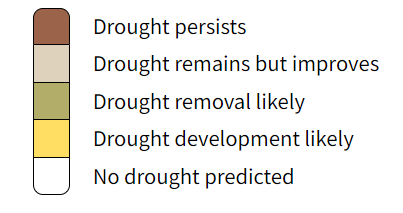State-wide Drought Declaration brings concerns for ag growing, fire seasons
- Jun 20, 2024
- 3 min read
June 20, 2024
By: Katherine Trowbridge

While snow fell last week in parts of Washington State, it seems to be too little, too late.
The Washington Department of Ecology brought forth a new Drought declaration in April of this year moving from a drought advisory. The Drought Declaration includes much of the state, with the exception of Seattle and parts of King County.
While rain fell in early June, it was not significant. Above normal temperatures and below normal precipitation continue to be the story.
The U.S. Seasonal Drought Outlook (pictured) predicts drought is likely to persist and become more severe across Washinton, the Idaho panhandle, and central Idaho from June–August 2024. Given these long-term forecasts, adverse effects of heat are expected for water supply, human health, and agricultural production.
This can also affect our upcoming fire season. With greater chances for fires to break out and spread rapidly due to dry conditions.
As reported by the Center Square, the Yakima Basin is in bad shape with a water supply forecast at 47% according to the U.S. Bureau of Reclamation. That’s the lowest since 2015.
The East Slope Cascade and Yakima Valley get their water supply from the Yakima River.
The Washington State Department of Ecology is taking applications from impacted growers to offset a small portion of what they are paying to lease water for crops. However, this is even dropping. Rates used to be 100%, in the last drought they were down to 50%.
The Kennewick Irrigation District has put forth a voluntary schedule with water conservation highly advised. Plans are in place as the weather warms up to manditorily enforce watering schedules.
South Columbia Basin Irrigation District Secretary-Manager John O’Callaghan said locally we are not going to be impacted. He stated that the vast majority of irrigation going on in Franklin County is from the Columbia Basin Project and privately held water rights.
O’Callaghan gets his statistics from the Oceanic Administration where run off into the Columbia River is stated to be at 75% of average. He anticipates a pretty average use year for irrigated water, which he said is a small portion in comparison.
Overall, O’Callaghan stated, with the damp and windy spring, he isn’t seeing any major drought concerns. Jokingly saying, “Isn’t it always a drought in Franklin County?”
O’Callaghan emphasized that Grant and Western Franklin Counties are basically “drought proof water systems” as they use water from the Grand Coulee Dam and Columbia Basin Project.
Typically, snowpack gradually melts off into streams and waterways in lower elevations over the season providing adequate water, but with a lower snowpack, less snowfall, and not even much rain, drought condidtions are continuing to get worse across the state of Washington.
The risk of wildland fires will increase as temperatures warm up over the summer months. Once again, northwestern Washington could see significant fires.
In Washington’s agricultural areas, junior water rights holders are expected to be curtailed earlier this season due to low snowpack. Pro-rateable water users in Yakima (i.e., water users with 1905 water rights), are forecasted to receive 46-54% percent of their water supply.
Forecasted high temperatures are expected to compound water supply challenges for producers, with higher evapotranspiration rates leading to increased water demand for irrigation. Producers therefore, should anticipate the need to fallow land and cease irrigation this summer season.
Dryland agriculture and pasture conditions are anticipated to deteriorate with higher-than-average temperatures. Hardship could include reduced water efficiency, lower stocking rates, and the need to haul water for livestock.
River flows are projected to decline to levels at which fish will not be able to migrate later this summer, resulting in stranding and premature death of critical species. Tribal nations and the U.S. Department of Fish and Wildlife are planning for low streamflows and taking proactive actions to respond early to these projected impacts. Fish hatchery operations are expected to be disrupted due to inadequate river flows.
Impacts are also anticipated on small and more vulnerable public water systems requiring water trucking, well deepening, and rehabilitation to support domestic water uses.
While water supply in the central mountains of Idaho was lower than initially forecasted, strong carryover storage and high baseflows allowed nearly all reservoirs to fill, which should help mitigate drought impacts through the summer on irrigated agriculture in southern Idaho.
However, northern Idaho is expecting much lower than normal streamflow throughout the summer, which is expected to limit power production and could result in increased stream temperatures should summer temperatures be higher than normal.





Comments